Paper Menu >>
Journal Menu >>
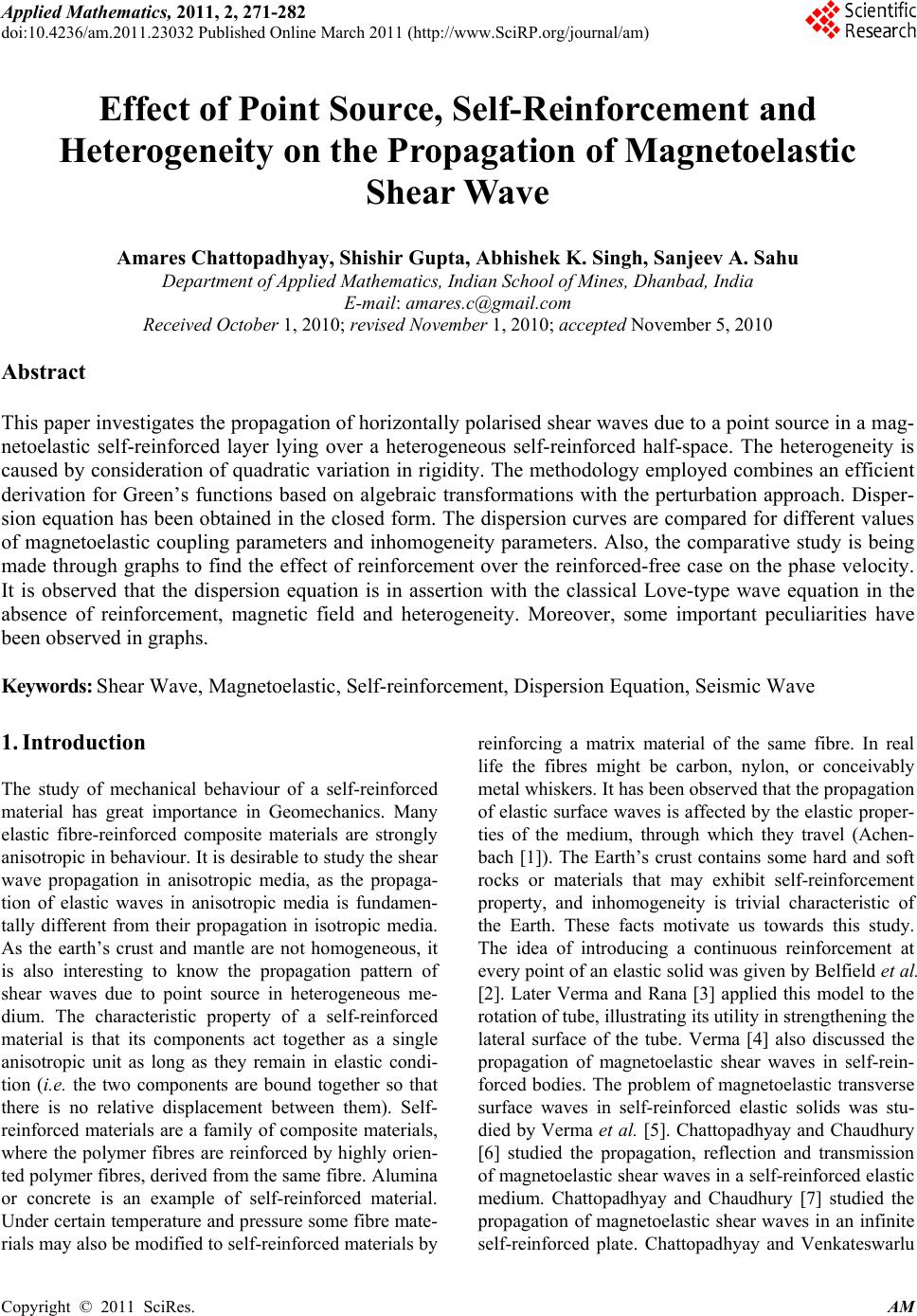 Applied Mathematics, 2011, 2, 271-282 doi:10.4236/am.2011.23032 Published Online March 2011 (http://www.SciRP.org/journal/am) Copyright © 2011 SciRes. AM Effect of Point Source, Self-Reinforcement and Heterogeneity on the Propagation of Magnetoelastic Shear Wave Amares Chattopadhyay, Shishir Gupta, Abhishek K. Singh, Sanjeev A. Sahu Department of Applied Mathe mat i cs, Indian Scho ol of Mines, Dhanbad, In di a E-mail: amares.c@gmail.com Received October 1, 2010; revised November 1, 2010; accepted November 5, 2010 Abstract This paper investigates the propagation of horizontally polarised shear waves due to a point source in a mag- netoelastic self-reinforced layer lying over a heterogeneous self-reinforced half-space. The heterogeneity is caused by consideration of quadratic variation in rigidity. The methodology employed combines an efficient derivation for Green’s functions based on algebraic transformations with the perturbation approach. Disper- sion equation has been obtained in the closed form. The dispersion curves are compared for different values of magnetoelastic coupling parameters and inhomogeneity parameters. Also, the comparative study is being made through graphs to find the effect of reinforcement over the reinforced-free case on the phase velocity. It is observed that the dispersion equation is in assertion with the classical Love-type wave equation in the absence of reinforcement, magnetic field and heterogeneity. Moreover, some important peculiarities have been observed in graphs. Keywords: Shear Wave, Magnetoelastic, Self-reinforcement, Dispersion Equation, Seismic Wave 1. Introduction The study of mechanical behaviour of a self-reinforced material has great importance in Geomechanics. Many elastic fibre-reinforced composite materials are strongly anisotropic in behaviour. It is desirable to study the shear wave propagation in anisotropic media, as the propaga- tion of elastic waves in anisotropic media is fundamen- tally different from their propagation in isotropic media. As the earth’s crust and mantle are not homogeneous, it is also interesting to know the propagation pattern of shear waves due to point source in heterogeneous me- dium. The characteristic property of a self-reinforced material is that its components act together as a single anisotropic unit as long as they remain in elastic condi- tion (i.e. the two components are bound together so that there is no relative displacement between them). Self- reinforced materials are a family of composite materials, where the polymer fibres are reinforced by highly orien- ted polymer fibres, derived from the same fibre. Alumina or concrete is an example of self-reinforced material. Under certain temperature and pressure some fibre mate- rials may also be modified to self-reinforced materials by reinforcing a matrix material of the same fibre. In real life the fibres might be carbon, nylon, or conceivably metal whiskers. It has been observed that the propagation of elastic surface waves is affected by the elastic proper- ties of the medium, through which they travel (Achen- bach [1]). The Earth’s crust contains some hard and soft rocks or materials that may exhibit self-reinforcement property, and inhomogeneity is trivial characteristic of the Earth. These facts motivate us towards this study. The idea of introducing a continuous reinforcement at every point of an elastic so lid was given by Belfield et al. [2]. Later Verma and Rana [3] applied this model to the rotation of tube, illustrating its utility in strengthening the lateral surface of the tube. Verma [4] also discussed the propagation of magnetoelastic shear waves in self-rein- forced bodies. The problem of magnetoelastic transverse surface waves in self-reinforced elastic solids was stu- died by Verma et al. [5]. Chattopadhyay and Chaudhury [6] studied the propagation, reflection and transmission of magnetoelastic shear waves in a self-reinforced elastic medium. Chattopadhyay and Chaudhury [7] studied the propagation of magnetoelastic shear waves in an infinite self-reinforced plate. Chattopadhyay and Venkateswarlu 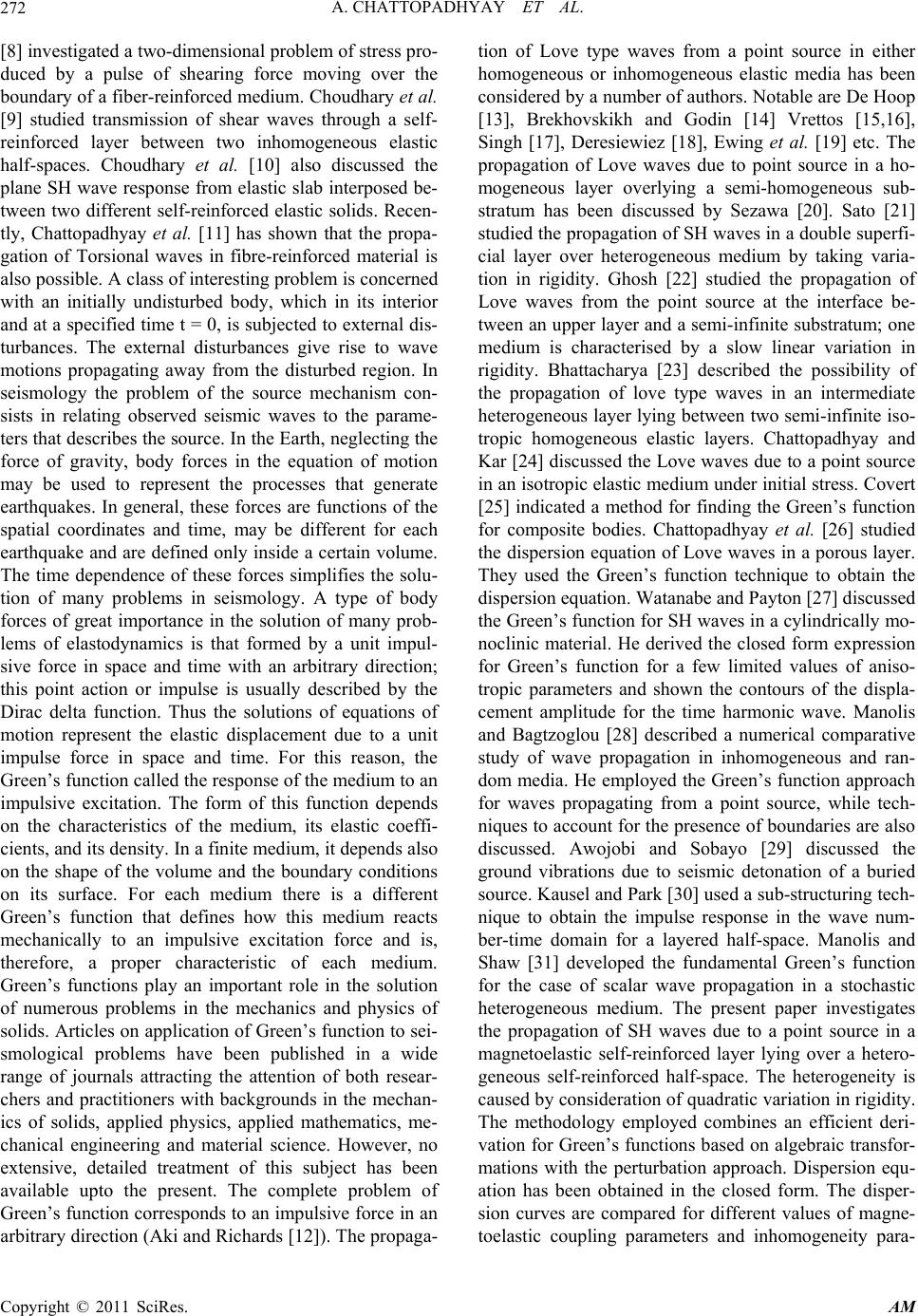 A. CHATTOPADHYAY ET AL. Copyright © 2011 SciRes. AM 272 [8] investigated a two-dimensional problem of stress pro- duced by a pulse of shearing force moving over the boundary of a fiber-reinforced medium. Choudhary et al. [9] studied transmission of shear waves through a self- reinforced layer between two inhomogeneous elastic half-spaces. Choudhary et al. [10] also discussed the plane SH wave response from elastic slab interposed be- tween two different self-reinforced elastic solids. Recen- tly, Chattopadhyay et al. [11] has shown that the propa- gation of Torsional waves in fibre-reinforced material is also possible. A class of interesting problem is concerned with an initially undisturbed body, which in its interior and at a specified time t = 0, is subjected to external dis- turbances. The external disturbances give rise to wave motions propagating away from the disturbed region. In seismology the problem of the source mechanism con- sists in relating observed seismic waves to the parame- ters that describes the source. In the Earth, neglecting the force of gravity, body forces in the equation of motion may be used to represent the processes that generate earthquakes. In general, these forces are functions of the spatial coordinates and time, may be different for each earthquake and are defined only inside a certain volume. The time dependence of these forces simplifies the solu- tion of many problems in seismology. A type of body forces of great importance in the solution of many prob- lems of elastodynamics is that formed by a unit impul- sive force in space and time with an arbitrary direction; this point action or impulse is usually described by the Dirac delta function. Thus the solutions of equations of motion represent the elastic displacement due to a unit impulse force in space and time. For this reason, the Green’s function called the response of the medium to an impulsive excitation. The form of this function depends on the characteristics of the medium, its elastic coeffi- cients, and its density. In a finite medium, it depends also on the shape of the volume and the boundary conditions on its surface. For each medium there is a different Green’s function that defines how this medium reacts mechanically to an impulsive excitation force and is, therefore, a proper characteristic of each medium. Green’s functions play an important role in the solution of numerous problems in the mechanics and physics of solids. Articles on app lication of Green’s function to sei- smological problems have been published in a wide range of journals attracting the attention of both resear- chers and practitioners with backgrounds in the mechan- ics of solids, applied physics, applied mathematics, me- chanical engineering and material science. However, no extensive, detailed treatment of this subject has been available upto the present. The complete problem of Green’s function corresponds to an impulsive force in an arbitrary direction (Aki and Richards [12]). The propaga- tion of Love type waves from a point source in either homogeneous or inhomogeneous elastic media has been considered b y a number o f author s. Notab le are De Hoop [13], Brekhovskikh and Godin [14] Vrettos [15,16], Singh [17], Deresiewiez [18], Ewing et al. [19] etc. The propagation of Love waves due to point source in a ho- mogeneous layer overlying a semi-homogeneous sub- stratum has been discussed by Sezawa [20]. Sato [21] studied the propagation of SH waves in a double superfi- cial layer over heterogeneous medium by taking varia- tion in rigidity. Ghosh [22] studied the propagation of Love waves from the point source at the interface be- tween an upper layer and a semi-infinite substratum; one medium is characterised by a slow linear variation in rigidity. Bhattacharya [23] described the possibility of the propagation of love type waves in an intermediate heterogeneous layer lying between two semi-infinite iso- tropic homogeneous elastic layers. Chattopadhyay and Kar [24] discussed the Love waves due to a point source in an isotrop ic elastic medium under initial stress. Covert [25] indicated a method for finding the Green’s function for composite bodies. Chattopadhyay et al. [26] studied the dispersion equation of Love waves in a porous layer. They used the Green’s function technique to obtain the dispersion equ at i on. Wat a nabe and Payton [27] discussed the Green’s function for SH waves in a cylindrically mo- noclinic material. He derived the closed form expression for Green’s function for a few limited values of aniso- tropic parameters and shown the contours of the displa- cement amplitude for the time harmonic wave. Manolis and Bagtzoglou [28] described a numerical comparative study of wave propagation in inhomogeneous and ran- dom media. He employed the Green’s function approach for waves propagating from a point source, while tech- niques to account for the presence of boundaries are also discussed. Awojobi and Sobayo [29] discussed the ground vibrations due to seismic detonation of a buried source. Kausel and Park [30] used a sub-structu ring tech- nique to obtain the impulse response in the wave num- ber-time domain for a layered half-space. Manolis and Shaw [31] developed the fundamental Green’s function for the case of scalar wave propagation in a stochastic heterogeneous medium. The present paper investigates the propagation of SH waves due to a point source in a magnetoelastic self-reinforced layer lying over a hetero- geneous self-reinforced half-space. The heterogeneity is caused by consideration of quadratic variation in rigidity. The methodology employed combines an efficient deri- vation for Green’s functions based on algebraic transfor- mations with the perturbation approach. Dispersion equ- ation has been obtained in the closed form. The disper- sion curves are compared for different values of magne- toelastic coupling parameters and inhomogeneity para-  A. CHATTOPADHYAY ET AL. Copyright © 2011 SciRes. AM 273 meters. Also, the comparative study is being made throu- gh graphs to find the effect of reinforcement over the reinforced-free case on the phase velocity. It is observed that the dispersion equation is in assertion with the clas- sical Love-type wave equation in the absence of rein- forcement, magnetic field and heterogeneity. 2. Formulation and Solution of the Problem We have considered a magnetoelastic self-reinforced layer of thickness H lying over a heterogeneous self- reinforced half-space. The x-axis has been taken along the propagation of waves and z-ax is is positive vertically downwards as shown in Figure 1. The source of distur- bance S is taken at the point of intersection of the inter- face of separation and z-axis. At first, we need to find the equation governing the propagation of SH wave in self reinforced magnetoelastic crustal layer. The constitutive equations used in a self-reinforced li- nearly elastic model are (Belfield et al. 1983) * * 2 2 ,,, 1,2,3 ijkkijT ijkm kmijkkij L Tikkjjkkikmkmi j eeaaeeaa aaeaaeaa eaa ijkm (1) where ij are components of stress, ij e components of infinitesimal strain, ij Kronecker delta, i acomponents of a , all referred to rectangular cartesian co-ordinates 123 ,, i x aaaa is the preferred directions of reinfor- cement such that 222 123 1aaa. The vector a may be function of position. Indices take the values 1, 2, 3 and summation convention is employed. The coefficients ** ,,, T and 2 L T are elastic constants with dimension of stress. T can be identified as the shear modulus in transverse shear across the preferred direc- tion, and L as the shear modulus in longitudinal shear in the preferred direction. * and * are specific stress components to take into account different layers for con- crete part of the composite material. The model consi- dered here is of transversely isotropic material, also z = 0 z = H Figure 1. Geometry of the problem. known as materials of hexagonal symmetry. Equations governing the propagation of small elastic disturbances in a perfectly conducting self-reinforced elastic medium having electromagnetic force J B (the Lorentz force, J being the electric current density and B being the magnetic induction vector) as the only body force are 2 ,2i ij ji u JB t (2) where i J B is the i x -component of the force J B and is the density of the layer. Here inte- raction of mechanical and electromagnetic fields is con- sidered. Let 11 1 ,, i uuvw and denoting 12 ,, x xx y 3 x z th en Equation (2) can be written as 2 13 11 121 2 2 23 12 221 2 2 13 23 331 2 x y z u JB xyz t v JB xyz t w JB xyz t (3) For SH wave propagating in the x-direction and caus- ing displacement in the y-direction only, we shall assume that 11 11 0,, ,uw vvxzt and 0. y (4) Using Equation (4) in Equation (3), we have 2 23 12 1 2 y v JB xz t (5) where 111 121 13TLT vvv aa a x xz 111 233 13TLT vvv aa a zxz For stresses 12 and 23 , the first part indicate the shear stress due to elastic members (steel) and the second part indicates effect of comparatively non-elastic mate- rial of the composite section in the same direction. The first component would be having the term T , which can be termed as elastic coefficient and L T in the second term amounts for the effect comparatively non-elastic portion of the composite ma- terial. The well known Maxwell’s equations governing the electromagnetic field are  A. CHATTOPADHYAY ET AL. Copyright © 2011 SciRes. AM 274 0,, , and . i e B BE HJ t u BH JEB t (6) where E is the induced electric field, J is the current density vector and magnetic field H includes both pri- mary and induced magnetic fields. e and are the induced permeability and conduction coefficient respec- tively. The linearized Maxwell’s stress tensor 0x M ij due to the magnetic field is given by 0x M ijeijj ik kij HbHb Hb . Let ,, x yz H HH H and 123 ,, . i bbbbi b is the change in the magnetic field. In writing the above equa- tions, we have neglected the displacement current. From Equation (6), we get 2. i e u H HH tt (7) In component form, Equation (7) can be written as 2 2 11 2 1, 1, 1 and . xx e zz e xz yy e HH t HH t vv HH Htt H txz (8) For perfectly conducting medium, (i.e. ), it can be seen that Equations (8) become 0, xz HH tt (9) and 11 . xz y vv HH Htt tx z (10) Assuming that primary magnetic field is uniform throughout the space. It is clear from Equation (10) that there is no perturbation in x H and z H , however from Equation (10) there may be perturbation in y H . There- fore, taking small perturbation, say 2 b in y H , we have 0102 2 , xy H HH Hb and 03, Z H Hwhere 01 0203 ,,HHH are components of the initial magnetic field 0 H . We can write 00 0 cos ,0,sinHH H , where 00 H H and is the angle at which the wave crosses the magnetic fiel d. Thus we have 020 cos ,,sinHH bH (11) We shall consider initial value of 2 bto be zero. Using Equation (11) in Equation (10), we get 11 00 2 cos sin . vv HH btt tx z (12) Integrating with respect to t, we get 11 20 0 cossin . vv bH H x z (13) Considering 2. 2 H H HHH and the Equations (6), we get 2. 2 eH J BHH (14) Using the Equations (1) and (14), we obtain the equa- tion of the motion for the magnetoelastic self-reinforced layer as 2222 111 1111 222 , vvvv PQR xz zx t (15) where 1222 30 1222 10 12 13 0 sin , cos and2sin 2. TLTe TLTe LT e Pa H Qa H Raa H (16) If 1,rt be the force density distribution in the upper layer due to the point source, the equation of mo- tion for SH wave propagation along x-axis becomes as 11 2222 1 1111 22 2 11 11 4,rt vvv v QR xz zx t PPP P (17) where r is the distance from the origin, where the force is applied to a point of coordinates and t is the time. Considering 11 ,,, it vxzt Vxze and 11 ,it rt re in Equation (17), we obtain 11 222 21 111 1 22 111 1 4r VVV QR V xz zx PP PP (18) where kc is the angular frequency, k the wave number and c is the phase velocity. Here the distur- bances caused by the impulsive force 1r may be represented in terms of Dirac-delta function at the so urce 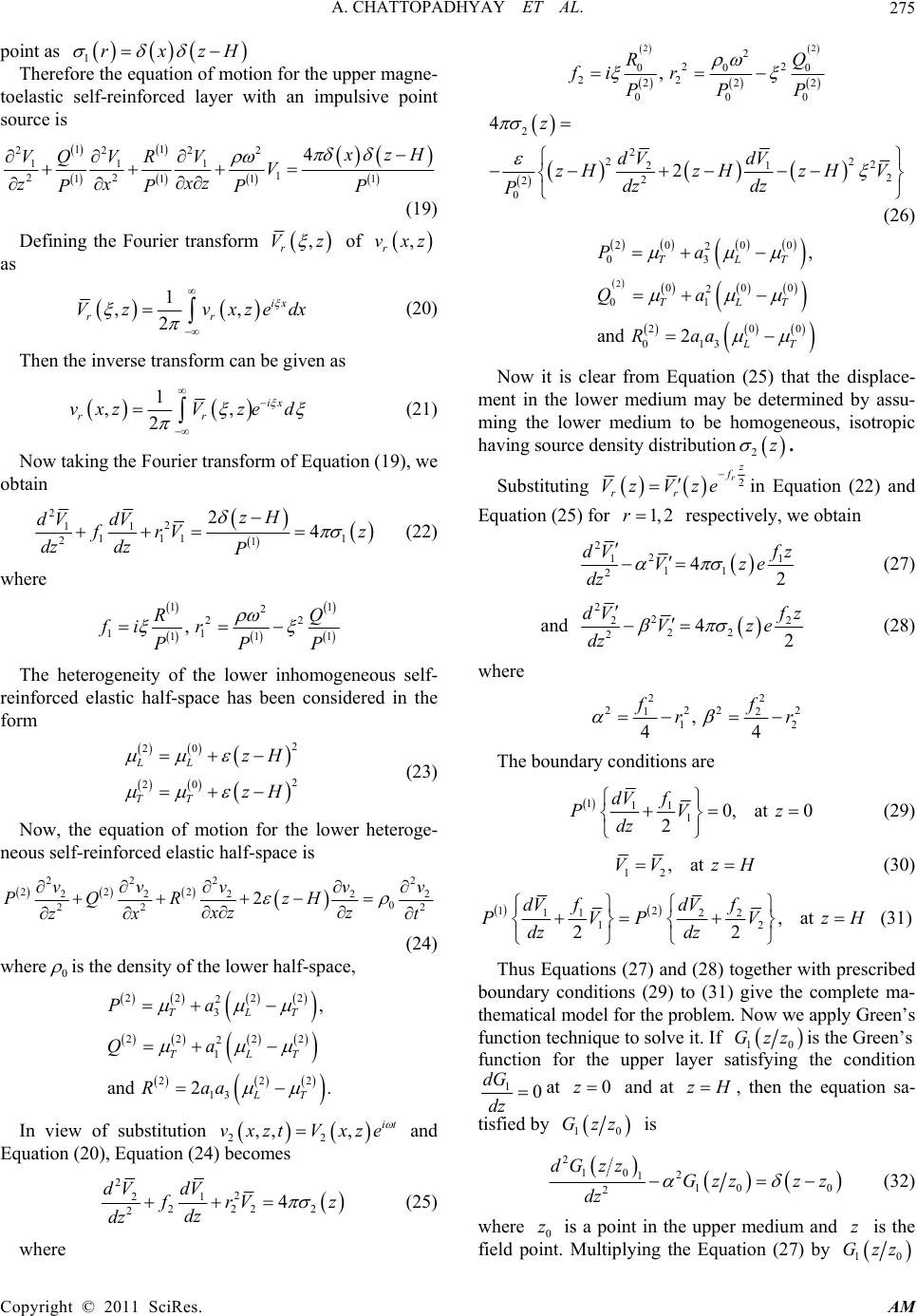 A. CHATTOPADHYAY ET AL. Copyright © 2011 SciRes. AM 275 point as 1rxzH Therefore the equation of motion for the upper magne- toelastic self-reinforced layer with an impulsive point source is 11 222 2 111 1 22 11 11 4 x zH VVV QR V xz zx PP PP (19) Defining the Fourier transform , r Vz of , r vxz as 1 ,, 2 ix rr Vz vxzedx (20) Then the inverse transform can be given as 1 ,, 2 ix rr vxzVze d (21) Now taking the Fourier transform of Equation (19), we obtain 22 11 111 1 21 24 zH dV dV f rV z dz dz P (22) where 11 2 22 11 111 , RQ fi r PPP The heterogeneity of the lower inhomogeneous self- reinforced elastic half-space has been considered in the form 2 20 2 20 LL TT zH zH (23) Now, the equation of motion for the lower heteroge- neous self-reinforced elastic half-space is 222 2 222 222 22 0 22 2 2 vvv vv PQR zH xz z zx t (24) where 0 is the density of the lower half-space, 22 22 2 3 22 22 2 1 222 13 , and 2. TLT TLT LT Pa Qa Raa In view of substitution 22 ,,, it vxztVxze and Equation (20), Equation (24) becomes 22 21 2222 24 dV dV f rV z dz dz (25) where 22 2 22 000 22 222 000 , RQ fir PPP 2 2 22 2 21 2 2 2 0 4 2 z dV dV zHzHzH V dz dz P (26) 2 20 00 2 03 000 2 01 200 013 , and 2 TLT TLT LT Pa Qa Raa Now it is clear from Equation (25) that the displace- ment in the lower medium may be determined by assu- ming the lower medium to be homogeneous, isotropic having source density distribution 2z . Substituting 2 r z f rr Vz Vze in Equation (22) and Equation (25) for 1, 2r respectively, we obtain 22 11 11 242 dV fz Vze dz (27) and 22 22 22 242 dV fz Vze dz (28) where 22 2222 12 12 , 44 ff rr The boundary conditions are 111 10, at0 2 dV f PVz dz (29) 12 ,atVV zH (30) 12 112 2 12 ,at 22 dV fdVf PVP VzH dz dz (31) Thus Equations (27) and (28) together with prescribed boundary conditions (29) to (31) give the complete ma- thematical model for the p roblem. Now we apply Green’s function technique to solve it. If 10 Gzzis the Green’s function for the upper layer satisfying the condition 10 dG dz at 0z and at zH, then the equation sa- tisfied by 10 Gzz is 210 2 1100 2 dG zzGzz zz dz (32) where 0 z is a point in the upper medium and z is the field point. Multiplying the Equation (27) by 10 Gzz 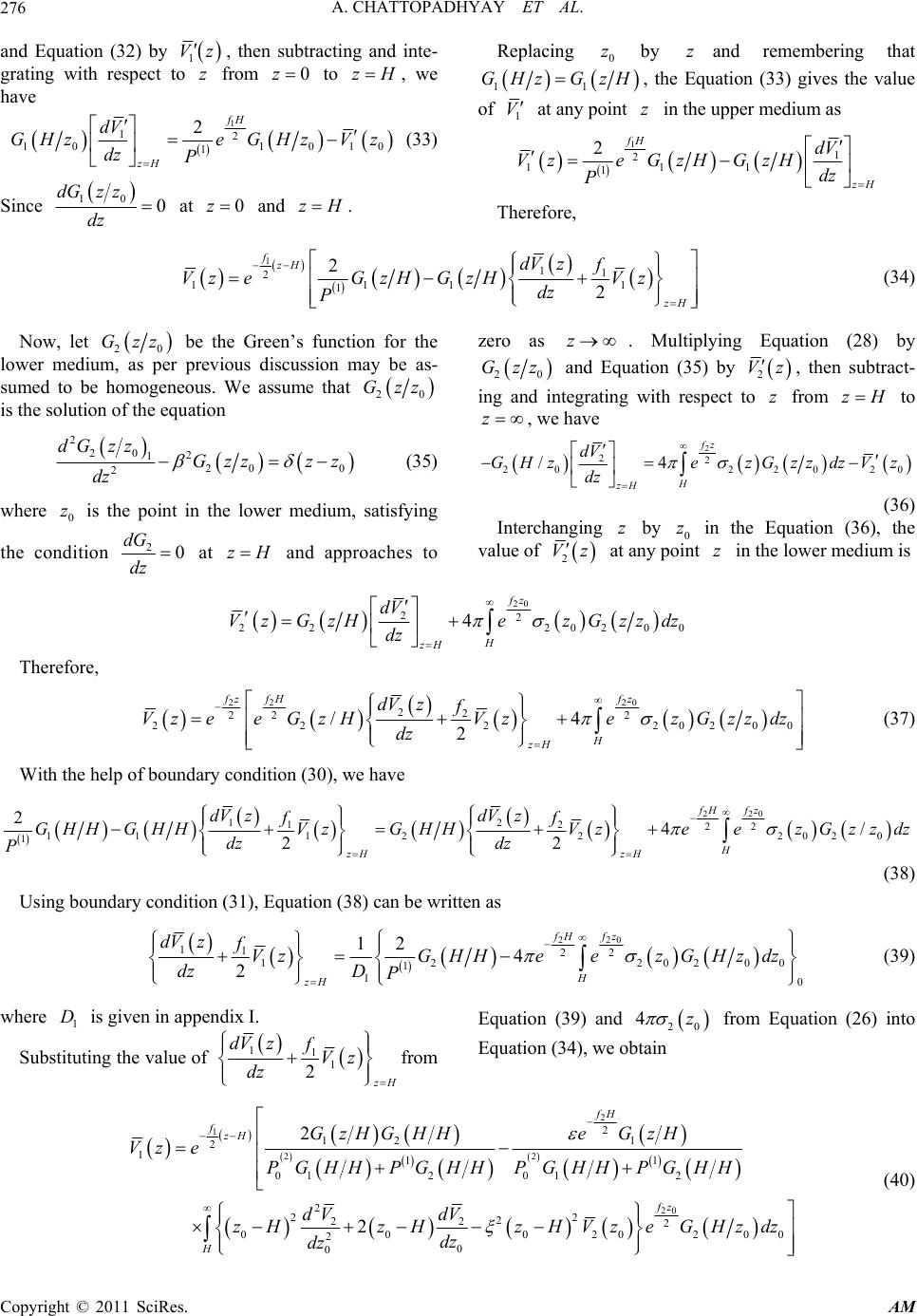 A. CHATTOPADHYAY ET AL. Copyright © 2011 SciRes. AM 276 and Equation (32) by 1 Vz , then subtracting and inte- grating with respect to z from 0z to zH , we have 1 12 10 1010 1 2fH zH dV GHzeGHzV z dz P (33) Since 10 0 dGz z dz at 0z and zH. Replacing 0 z by zand remembering that 11 GHz GzH, the Equation (33) gives the value of 1 V at any point z in the upper medium as 11 2 111 1 2fH z H dV VzeGzH GzHdz P Therefore, 111 2 1111 1 2 2 fzH zH dV zf VzeGzHGzHVz dz P (34) Now, let 20 Gzz be the Green’s function for the lower medium, as per previous discussion may be as- sumed to be homogeneous. We assume that 20 Gzz is the solution of the equation 220 2 1200 2 dG zzGzz zz dz (35) where 0 z is the point in the lower medium, satisfying the condition 20 dG dz at zH and approaches to zero as z . Multiplying Equation (28) by 20 Gzz and Equation (35) by 2 Vz , then subtract- ing and integrating with respect to z from zH to z , we have 2 22 2022020 /4 fz H zH dV GHzezGzzdzVz dz (36) Interchanging z by 0 z in the Equation (36), the value of 2 Vz at an y point z in the lower medium is 20 22 22 20200 4fz H zH dV Vz GzHezGzzdz dz Therefore, 20 22 22 22 2 222 20200 /4 2 fz fz fH H zH dV zf Vzee GzHVzezGzzdz dz (37) With the help of bound ary condition (30), we have 20 2 12 12 22 111 222020 1 24/ 22 fz fH H zH zH dV zdVz ff GHH GHHVzGHHVzeezGzzdz dz dz P (38) Using boundary condition (31), Equation (38) can be written as 20 2 1122 12 20200 1 10 12 4 2 fz fH H zH dV zfVzGHHeezGHzdz dzD P (39) where 1 D is given in appendix I. Substituting the value of 111 2 z H dV zfVz dz from Equation (39) and 20 4z from Equation (26) into Equation (34), we obtain 2 1 22 20 2 12 1 2 111 01 201 2 2 22 2 22 2 00020200 20 0 2 2 fH fzH fz H GzHGHHe GzH Vz ePGHHP GHHPGHHP GHH dV dV zHzH zHVzeGHzdz dz dz (40) 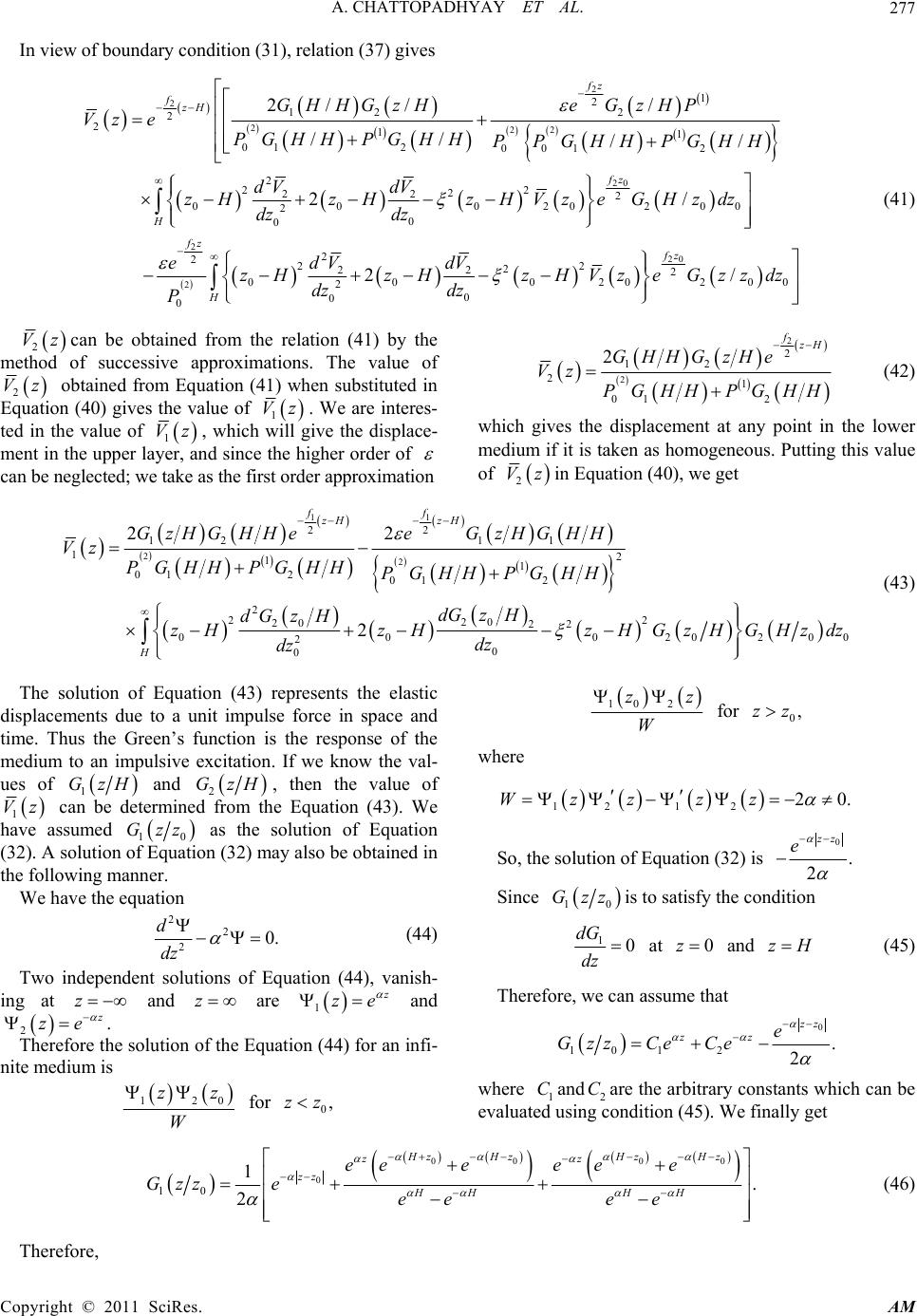 A. CHATTOPADHYAY ET AL. Copyright © 2011 SciRes. AM 277 In view of boundary condition (31), relation (37) gives 2 2 222 20 2 2 1 2 12 2 2 211 012 001 2 2 22 2 22 2 00020200 20 0 2 222 2 22 00020 20 0 0 2/ // // // 2/ 2 fz fzH fz H fz GHHGzHe GzHP Vz ePGHH PGHHPPGHHPGHH dV dV zHzH zHVzeGHzdz dz dz dV dV ezHzH zHVz dz dz P 20 2200 / fz H eGzzdz (41) 2 Vzcan be obtained from the relation (41) by the method of successive approximations. The value of 2 Vz obtained from Equation (41) when substituted in Equation (40) gives the value of 1 Vz. We are interes- ted in the value of 1 Vz, which will give the displace- ment in the upper layer, and since the higher order of can be neglected; we ta ke as th e fi rst order ap pro ximation 2 2 2 12 21 01 2 2fzH GHHGzHe Vz PGHHP GHH (42) which gives the displacement at any point in the lower medium if it is taken as homogeneous. Putting this value of 2 Vzin Equation (40), we get 11 22 22 12 11 12 11 012 01 2 2 2 2 20 20 2 2 00020200 20 0 22 2 ff zH zH H GzHGHHee GzHGHH Vz PGHHP GHHPGHHPGHH dGz H dGz H zH zH zHGzHGHzdz dz dz (43) The solution of Equation (43) represents the elastic displacements due to a unit impulse force in space and time. Thus the Green’s function is the response of the medium to an impulsive excitation. If we know the val- ues of 1 GzH and 2 GzH, then the value of 1 Vz can be determined from the Equation (43). We have assumed 10 Gzz as the solution of Equation (32). A solution of Equation (32) may also be ob tained in the following manner. We have the equation 22 20. d dz (44) Two independent solutions of Equation (44), vanish- ing at z and z are 1 z ze and 2 z ze . Therefore the solution of th e Equation (44) for an infi- nite medium is 120 zz W for 0,zz 10 2 zz W for 0,zz where 121 220.Wzz zz So, the solution of Equation (32) is 0. 2 zz e Since 10 Gzzis to satisfy the cond ition 10 dG dz at 0z and zH (45) Therefore, we can assume that 0 10 12. 2 zz zz e GzzCeCe where 12 andCCare the arbitrary constants which can be evaluated using condition (45). We finally get 00 00 0 101. 2 Hz HzHz Hz zz zz HH HH eeee ee Gzz eee ee (46) Therefore, 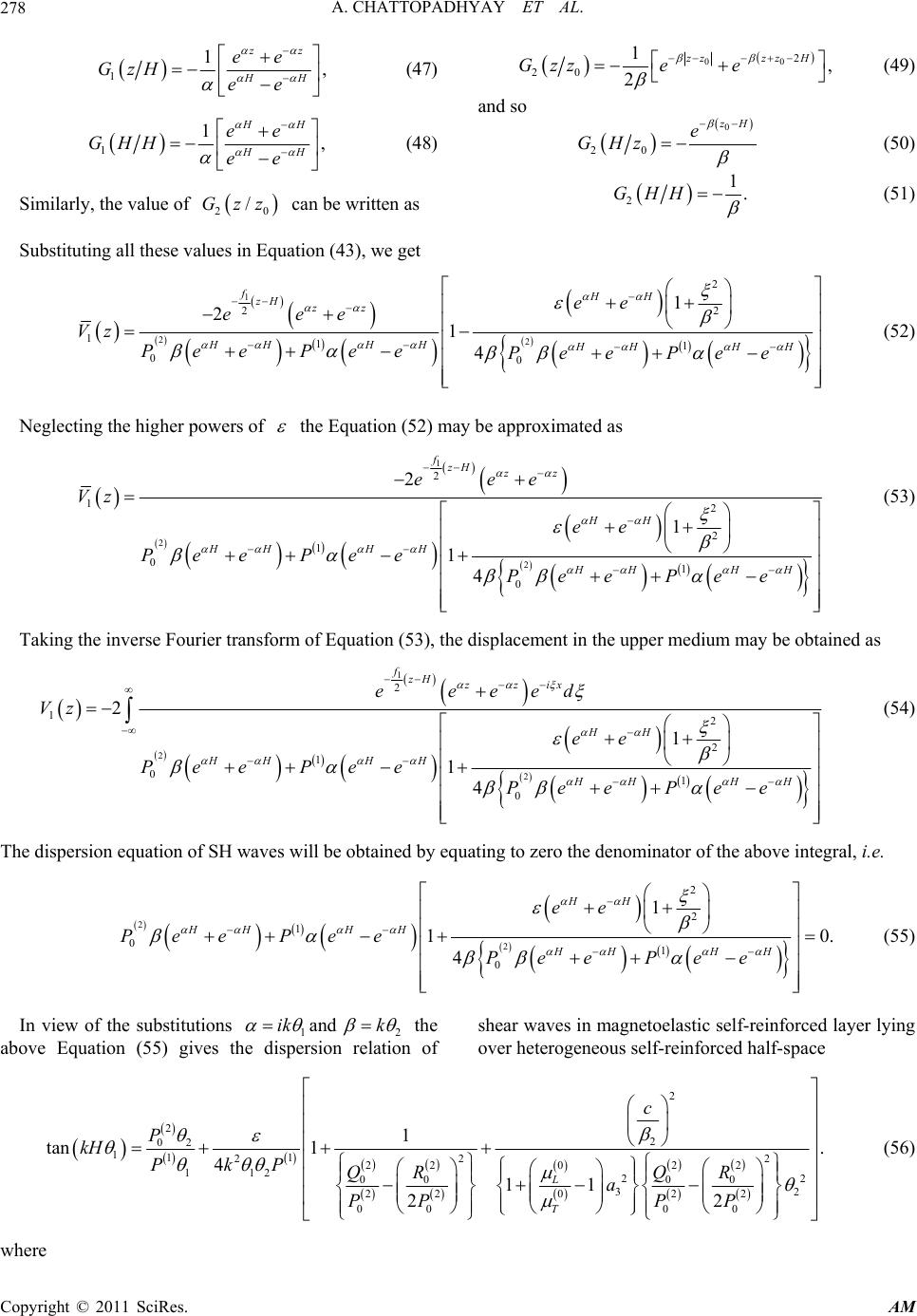 A. CHATTOPADHYAY ET AL. Copyright © 2011 SciRes. AM 278 11, zz HH ee GzH ee (47) 11, HH HH ee GHH ee (48) Similarly, the value of 20 /Gzz can be written as 00 2 20 1, 2 zzzz H Gzze e (49) and so 0 20 z H e GHz (50) 21.GHH (51) Substituting all these values in Equation (43), we get 1 22 2 22 111 00 1 214 fHH zH zz HH HHHHHH ee eee Vz Pee PeePeePee (52) Neglecting the higher powers of the Equation (52) may be approximated as 1 2 2 2 12 2 1 01 0 2 1 14 fzHzz HH HH HH HH HH eee Vz ee Pee PeePee Pee (53) Taking the inverse Fourier transform of Equation (53), the displacement in the upper medium may be obtained as 1 2 2 2 12 2 1 01 0 2 1 14 fzHzzix HH HH HH HH HH eeeed Vz ee Pee PeePee Pee (54) The dispersion equation of SH waves will be obtained by equating to zero the denominator of the above in tegral, i.e. 2 2 2 2 1 01 0 1 10. 4 HH HH HH HH HH ee Pee PeePee Pee (55) In view of the substitutions 12 andik k the above Equation (55) gives the dispersion relation of shear waves in magnetoelastic self-reinforced layer lying over hetero geneous self-reinforced hal f -space 2 22 02 111 22 222 22 0 112 22 00 00 32 22022 00 00 1 tan 1. 411 22 L T c P kH PkPQR QR a PP PP (56) where 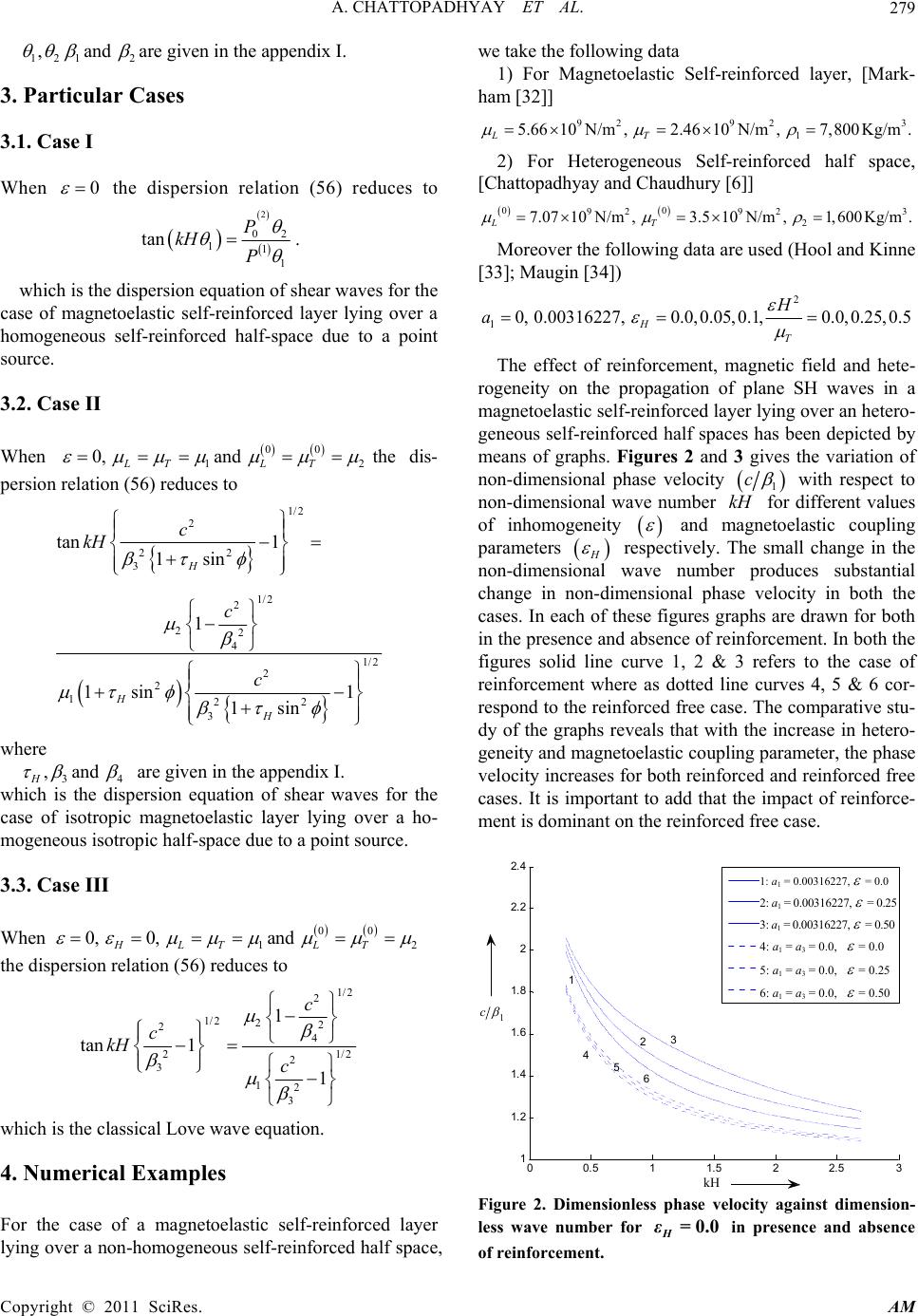 A. CHATTOPADHYAY ET AL. Copyright © 2011 SciRes. AM 279 121 2 ,and are given in the appendix I. 3. Particular Cases 3.1. Case I When 0 the dispersion relation (56) reduces to 2 02 111 tan P kH P . which is the dispersion equation of shear waves for the case of magnetoelastic self-reinforced layer lying over a homogeneous self-reinforced half-space due to a point source. 3.2. Case II When 00 12 0, and LTL T the dis- persion relation (56) reduces to 1/2 2 22 3 1/2 2 22 4 1/2 2 2 122 3 tan 1 1sin 1 1sin 1 1sin H H H c kH c c where 34 ,and H are given in the appendix I. which is the dispersion equation of shear waves for the case of isotropic magnetoelastic layer lying over a ho- mogeneous isotropic half-space due to a point source. 3.3. Case III When 00 12 0, 0,and HLT LT the dispersion relation (56) reduces to 1/2 2 1/2 22 24 21/2 2 3 12 3 1 tan 1 1 c c kH c which is the classical Love wave equation. 4. Numerical Examples For the case of a magnetoelastic self-reinforced layer lying over a non-homogeneous self-reinforced half space, we take the following data 1) For Magnetoelastic Self-reinforced layer, [Mark- ham [32]] 92 923 1 5.6610 N/m ,2.4610 N/m ,7,800Kg/m. LT 2) For Heterogeneous Self-reinforced half space, [Chattopadhyay and Chaudhur y [6]] 00 92 923 2 7.0710 N/m ,3.510 N/m ,1,600Kg/m. LT Moreover the following data are used (Hool and Kinne [33]; Maugin [34]) 2 10,0.00316227,0.0,0.05,0.1,0.0,0.25,0.5 HT H a The effect of reinforcement, magnetic field and hete- rogeneity on the propagation of plane SH waves in a magnetoelastic self-reinforced layer lying over an hetero- geneous self-reinforced half spaces has been depicted by means of graphs. Figures 2 and 3 gives the variation of non-dimensional phase velocity 1 c with respect to non-dimensional wave number kH for different values of inhomogeneity and magnetoelastic coupling parameters H respectively. The small change in the non-dimensional wave number produces substantial change in non-dimensional phase velocity in both the cases. In each of these figures graphs are drawn for both in the presence and absence of reinforcement. In both the figures solid line curve 1, 2 & 3 refers to the case of reinforcement where as dotted line curves 4, 5 & 6 cor- respond to the reinforced free case. The comparative stu- dy of the graphs reveals that with the increase in hetero- geneity and magnetoelastic coupling parameter, the phase velocity increases for both reinforced and reinforced free cases. It is important to add that the impact of reinforce- ment is dominant on the reinforced free case. 00.5 11.5 22.5 3 1 1. 2 1. 4 1. 6 1. 8 2 2. 2 2. 4 kH c/ 1 1 23 456 1: a 1 =0.00316227, =0.0 2: a 1 =0.00316227, =0.25 3: a 1 =0.00316227, =0.50 4: a 1 =a 3 =0.0, =0.0 5: a 1 =a 3 =0.0, =0.25 6: a 1 =a 3 =0.0, =0.50 Figure 2. Dimensionless phase velocity against dimension- less wave number for =0.0 H ε in presence and absence of reinforcement. 1: a1 = 0.00316227, = 0.0 2: a1 = 0.00 316227 , = 0.25 3: a1 = 0.00316227, = 0.50 4: a1 = a3 = 0.0, = 0.0 5: a1 = a3 = 0.0, = 0.25 6: a1 = a3 = 0.0, = 0.50 kH 1 c 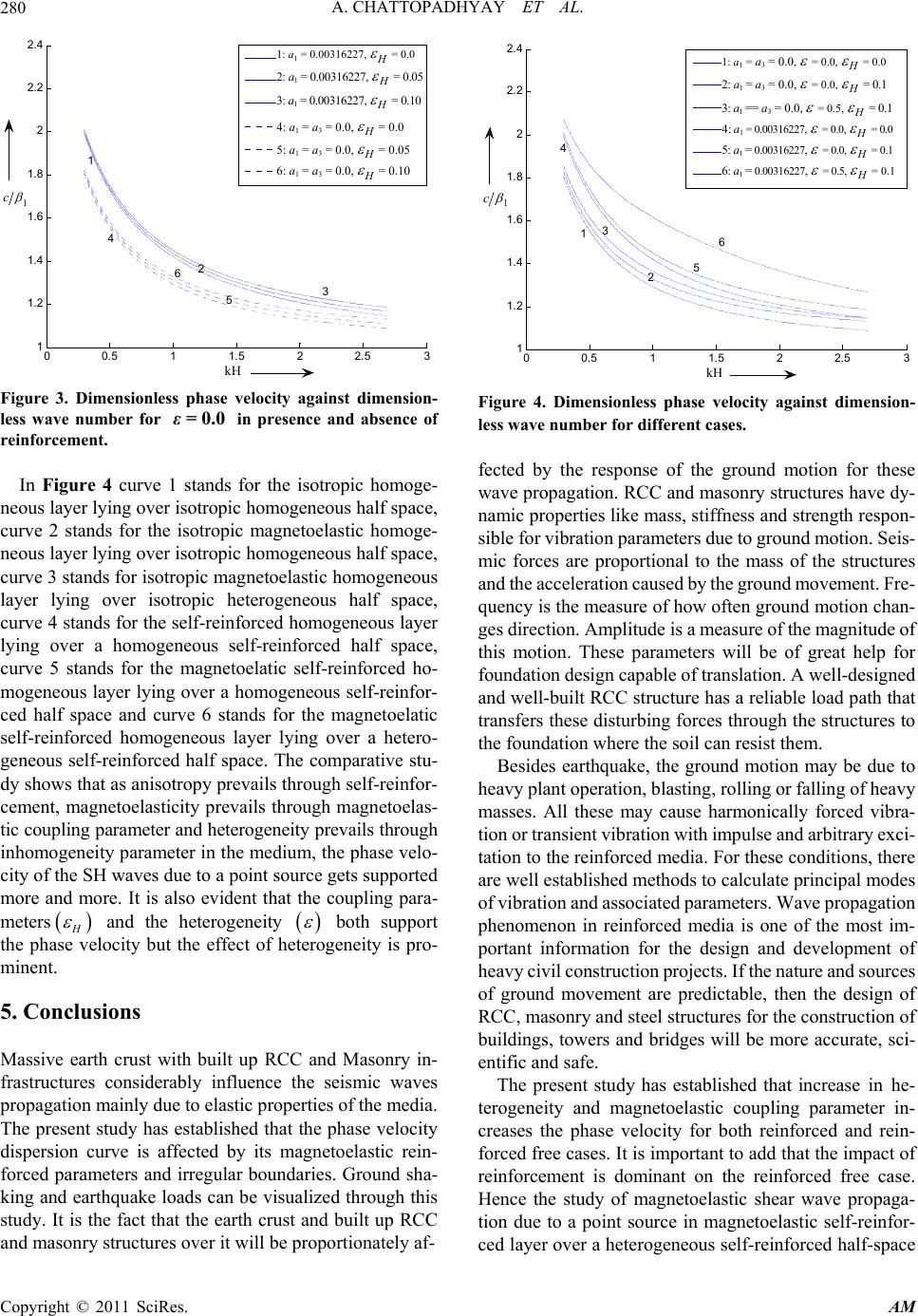 A. CHATTOPADHYAY ET AL. Copyright © 2011 SciRes. AM 280 00.5 11.5 22.5 3 1 1.2 1.4 1.6 1.8 2 2.2 2.4 kH c/ 1 1 2 3 4 5 6 1: a 1 =0.00316227, H =0.0 2: a 1 =0.00316227, H =0.05 3: a 1 =0.00316227, H =0.10 4: a 1 =a 3 =0.0, H =0.0 5: a 1 =a 3 =0.0, H =0.05 6: a 1 =a 3 =0.0, H =0.10 Figure 3. Dimensionless phase velocity against dimension- less wave number for =0.0ε in presence and absence of reinforcement. In Figure 4 curve 1 stands for the isotropic homoge- neous layer lying over isotropic homogeneous half space, curve 2 stands for the isotropic magnetoelastic homoge- neous layer lying over isotropic homogeneous half space, curve 3 stands for isotropic magnetoelastic homogeneous layer lying over isotropic heterogeneous half space, curve 4 stands for the self-rein forced homogeneous layer lying over a homogeneous self-reinforced half space, curve 5 stands for the magnetoelatic self-reinforced ho- mogeneous layer lying over a homogeneous self-reinfor- ced half space and curve 6 stands for the magnetoelatic self-reinforced homogeneous layer lying over a hetero- geneous self-reinforced half space. The comparative stu- dy shows that as anisotrop y prevails through self-r einfor- cement, magnetoelasticity prevails through magnetoelas- tic coupling parameter and heteroge neity prevails thro ugh inhomogeneity parameter in the medium, the phase velo- city of the SH waves due to a poin t sour ce gets suppor ted more and more. It is also evident that the coupling para- meters H and the heterogeneity both support the phase velocity but the effect of heterogeneity is pro- minent. 5. Conclusions Massive earth crust with built up RCC and Masonry in- frastructures considerably influence the seismic waves propagation mainly due to elast i c pr operties of the media. The present study has established that the phase velocity dispersion curve is affected by its magnetoelastic rein- forced parameters and irregular boundaries. Ground sha- king and earthquake loads can be visualized through this study. It is the fact that the earth crust and built up RCC and masonry structures over it will be proportiona tely af- 00.5 11.5 22.5 3 1 1. 2 1. 4 1. 6 1. 8 2 2. 2 2. 4 kH c/ 1 1 2 3 4 5 6 1: a 1 =a 3 =0.0, =0.0, H =0.0 2: a 1 =a 3 =0.0, =0.0, H =0.1 3: a 1 =a 3 =0.0, =0.5, H =0.1 4: a 1 =0.00316227, =0.0, H =0.0 5: a 1 =0.00316227, =0.0, H =0.1 6: a 1 =0.00316227, =0.5, H =0.1 Figure 4. Dimensionless phase velocity against dimension- less wave number for different cases. fected by the response of the ground motion for these wave propagation. RCC and masonr y structures hav e dy- namic properties like mass, stiffness and strength respon- sible for vibrati on parame ters due to grou nd motion. Seis- mic forces are proportional to the mass of the structures and the acceleration caused by the ground movement. Fre- quency is the measure of how often ground motion chan- ges direction. Am plitude is a m easure of the magni tude of this motion. These parameters will be of great help for foundatio n design capa ble of translat ion. A well -designed and well-built RCC structure has a reliable load path that transfers these disturbing forces through the structures to the foundation where the soil can resist them. Besides earthquake, the ground motion may be due to heavy plant operation, blasting, rolling or falling of heavy masses. All these may cause harmonically forced vibra- tion or transi ent vibr ation with im pulse and ar bitrary exci- tation to the reinforced media. For th ese conditio ns, there are well established methods to calculate principal modes of vibration and associated param eters. Wave propagation phenomenon in reinforced media is one of the most im- portant information for the design and development of heavy civil co nstruction pr ojects. If the nat ure and source s of ground movement are predictable, then the design of RCC, masonry and steel structures for the construction of buildings, towers and bridges will be more accurate, sci- entific and safe. The present study has established that increase in he- terogeneity and magnetoelastic coupling parameter in- creases the phase velocity for both reinforced and rein- forced free cases. It is important to add that the impact of reinforcement is dominant on the reinforced free case. Hence the study of magnetoelastic shear wave propaga- tion due to a point source in magnetoelastic self-reinfor- ced layer over a heterogeneous self-reinforced half-space 1: a1 = 0.00316227, H = 0.0 2: a1 = 0.00 316227 , H = 0.05 3: a1 = 0.00316227, H = 0.10 4: a1 = a3 = 0.0, H = 0.0 5: a1 = a3 = 0.0, H = 0.05 6: a1 = a3 = 0.0, H = 0.10 kH 1 c kH 1: a1 = a3 = 0.0, = 0.0, H = 0.0 2: a1 = a3 = 0.0, = 0.0, H = 0.1 3: a1 == a3 = 0.0, = 0.5, H = 0.1 4: a1 = 0.00316 227, = 0.0, H = 0.0 5: a1 = 0.003 16227, = 0.0, H = 0.1 6: a1 = 0.00316227, = 0.5, H = 0.1 1 c 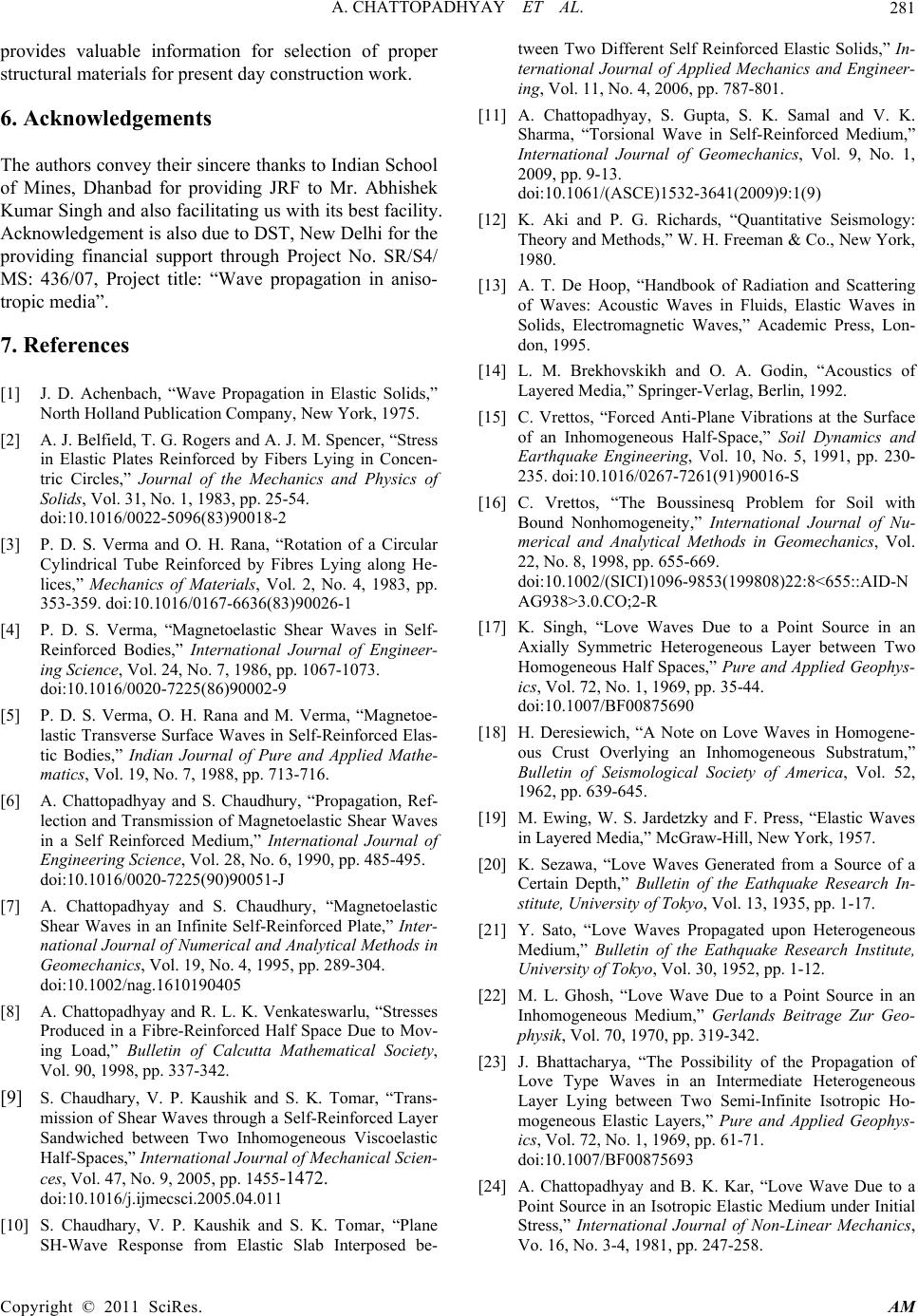 A. CHATTOPADHYAY ET AL. Copyright © 2011 SciRes. AM 281 provides valuable information for selection of proper structural materials for present day construction work. 6. Acknowledgements The authors convey their sincere thanks to Indian School of Mines, Dhanbad for providing JRF to Mr. Abhishek Kumar Singh and also facilitating us with its best facility. Acknowledgement is also due to DST, New Delhi for the providing financial support through Project No. SR/S4/ MS: 436/07, Project title: “Wave propagation in aniso- tropic media”. 7. References [1] J. D. Achenbach, “Wave Propagation in Elastic Solids,” North Holland Publication Company, New York, 1975. [2] A. J. Belfield, T. G. Rogers and A. J. M. Spencer, “Stress in Elastic Plates Reinforced by Fibers Lying in Concen- tric Circles,” Journal of the Mechanics and Physics of Solids, Vol. 31, No. 1, 1983, pp. 25-54. doi:10.1016/0022-5096(83)90018-2 [3] P. D. S. Verma and O. H. Rana, “Rotation of a Circular Cylindrical Tube Reinforced by Fibres Lying along He- lices,” Mechanics of Materials, Vol. 2, No. 4, 1983, pp. 353-359. doi:10.1016/0167-6636(83)90026-1 [4] P. D. S. Verma, “Magnetoelastic Shear Waves in Self- Reinforced Bodies,” International Journal of Engineer- ing Science, Vol. 24, No. 7, 1986, pp. 1067-1073. doi:10.1016/0020-7225(86)90002-9 [5] P. D. S. Verma, O. H. Rana and M. Verma, “Magnetoe- lastic Transverse Surface Waves in Self-Reinforced Elas- tic Bodies,” Indian Journal of Pure and Applied Mathe- matics, Vol. 19, No. 7, 1988, pp. 713-716. [6] A. Chattopadhyay and S. Chaudhury, “Propagation, Ref- lection and Transmission of Magnetoelastic Shear Waves in a Self Reinforced Medium,” International Journal of Engineering Science, Vol. 28, No. 6, 1990, pp. 485-495. doi:10.1016/0020-7225(90)90051-J [7] A. Chattopadhyay and S. Chaudhury, “Magnetoelastic Shear Waves in an Infinite Self-Reinforced Plate,” Inter- national Journal of Numerical and Analytical Methods in Geomechanics, Vol. 19, No. 4, 1995, pp. 289-304. doi:10.1002/nag.1610190405 [8] A. Chattopadhyay and R. L. K. Venkateswarlu, “Stre sses Produced in a Fibre-Reinforced Half Space Due to Mov- ing Load,” Bulletin of Calcutta Mathematical Society, Vol. 90, 1998, pp. 337-342. [9] S. Chaudhary, V. P. Kaushik and S. K. Tomar, “Trans- mission of Shear Waves through a Self-Reinforced Layer Sandwiched between Two Inhomogeneous Viscoelastic Half-Spaces,” International Journal of Mechanical Scien- ces, Vol. 47, No. 9, 2005, pp. 1455-1472. doi:10.1016/j.ijmecsci.2005.04.011 [10] S. Chaudhary, V. P. Kaushik and S. K. Tomar, “Plane SH-Wave Response from Elastic Slab Interposed be- tween Two Different Self Reinforced Elastic Solids,” In- ternational Journal of Applied Mechanics and Engineer- ing, Vol. 11, No. 4, 2006, pp. 787-801. [11] A. Chattopadhyay, S. Gupta, S. K. Samal and V. K. Sharma, “Torsional Wave in Self-Reinforced Medium,” International Journal of Geomechanics, Vol. 9, No. 1, 2009, pp. 9-13. doi:10.1061/(ASCE)1532-3641(2009)9:1(9) [12] K. Aki and P. G. Richards, “Quantitative Seismology: Theory and Methods,” W. H. Freeman & Co., New York, 1980. [13] A. T. De Hoop, “Handbook of Radiation and Scattering of Waves: Acoustic Waves in Fluids, Elastic Waves in Solids, Electromagnetic Waves,” Academic Press, Lon- don, 1995. [14] L. M. Brekhovskikh and O. A. Godin, “Acoustics of Layered Media,” Springer-Verlag, Berlin, 1992. [15] C. Vrettos, “Forced Anti-Plane Vibrations at the Surface of an Inhomogeneous Half-Space,” Soil Dynamics and Earthquake Engineering, Vol. 10, No. 5, 1991, pp. 230- 235. doi:10.1016/0267-7261(91)90016-S [16] C. Vrettos, “The Boussinesq Problem for Soil with Bound Nonhomogeneity,” International Journal of Nu- merical and Analytical Methods in Geomechanics, Vol. 22, No. 8, 1998, pp. 655-669. doi:10.1002/(SICI)1096-9853(199808)22:8<655::AID-N AG938>3.0.CO;2-R [17] K. Singh, “Love Waves Due to a Point Source in an Axially Symmetric Heterogeneous Layer between Two Homogeneous Half Spaces,” Pure and Applied Geophys- ics, Vol. 72, No. 1, 1969, pp. 35-44. doi:10.1007/BF00875690 [18] H. Deresiewich, “A Note on Love Waves in Homogene- ous Crust Overlying an Inhomogeneous Substratum,” Bulletin of Seismological Society of America, Vol. 52, 1962, pp. 639-645. [19] M. Ewing, W. S. Jardetzky and F. Press, “Elastic Waves in Layered Media,” McGraw-Hill, New York, 1957. [20] K. Sezawa, “Love Waves Generated from a Source of a Certain Depth,” Bulletin of the Eathquake Research In- stitute, University of Tokyo, Vol. 13, 1935, pp. 1-17. [21] Y. Sato, “Love Waves Propagated upon Heterogeneous Medium,” Bulletin of the Eathquake Research Institute, University of Tokyo, Vol. 30, 1952, pp. 1-12. [22] M. L. Ghosh, “Love Wave Due to a Point Source in an Inhomogeneous Medium,” Gerlands Beitrage Zur Geo- physik, Vol. 70, 1970, pp. 319-342. [23] J. Bhattacharya, “The Possibility of the Propagation of Love Type Waves in an Intermediate Heterogeneous Layer Lying between Two Semi-Infinite Isotropic Ho- mogeneous Elastic Layers,” Pure and Applied Geophys- ics, Vol. 72, No. 1, 1969, pp. 61-71. doi:10.1007/BF00875693 [24] A. Chattopadhyay and B. K. Kar, “Love Wave Due to a Point Source in an Isotropic Elastic Medium under Initial Stress,” International Journal of Non-Linear Mechanics, Vo. 16, No. 3-4, 1981, pp. 247-258.  A. CHATTOPADHYAY ET AL. Copyright © 2011 SciRes. AM 282 doi:10.1016/0020-7462(81)90038-X [25] E. D. Covert, “Approximate Calculation of Green’s Function for Built-Up Bodies,” Journal of Mathematical Physics, Vol. 37, No. 1, 1958, pp. 58-65. [26] A. Chattopadhyay, M. Chakraborty and V. Kaushwaha, “On the Dispersion Equation of Love Waves in a Porous Layer,” Acta Mechanica, Vol. 58, No. 3-4, 1986, pp. 125- 136. doi:10.1007/BF01176595 [27] K. Watanabe and R. G. Payton, “Green’s Function for SH-Wave in Cylindrically Monoclinic Material,” Journal of Mechanics and Physics, Vol. 50, No. 11, 2002, pp. 2425-2439. doi:10.1016/S0022-5096(02)00026-1 [28] G. D. Manolis and A. C. Bagtzoglou, “A Numerical Comparative Study of Wave Propagation in Inhomoge- neous and Random Media,” Computational Mechanics, Vol. 10, No. 6, 1992, pp. 397-413. doi:10.1007/BF00363995 [29] A. O. Awojobi and O. A. Sobayo, “Ground Vibration Due to Seismic Detonation of a Buried Source,” Earth- quake Engineering and Structural Dynamics, Vol. 5, No. 2, 2006, pp. 131-143. doi:10.1002/eqe.4290050203 [30] E. Kausel and J. Park, “Impulse Response of Elastic Half-Space in the Wave Number-Time Domain,” Journal of Engineering Mechanics ASCE, Vol. 130, No. 10, 2004, pp. 1211-1222. doi:10.1061/(ASCE)0733-9399(2004)130:10(1211) [31] G. D. Manolis and R. P. Shaw, “Wave Motions in Sto- chastic Heterogenous Media,” Engineering Analysis with Boundary Element, Vol. 15, No. 3, 1995, pp. 225-234. doi:10.1016/0955-7997(95)00026-K [32] M. F. Markham, “Measurements of Elastic Constants of Fibre Composite by Ultrasonics,” Composites, Vol. 1, 1970, pp. 145-149. doi:10.1016/0010-4361(70)90477-5 [33] G. A. Hool and W. S. Kinne, “Reinforced Concrete and Masonry Structure,” McGraw-Hill, New York, 1924. [34] G. A. Maugin, “Review Article: Wave Motion in Magne- tizable Deformable Solids,” International Journal of En- gineering Science, Vol. 19, No. 3, 1981, pp. 321-388. doi:10.1016/0020-7225(81)90059-8 Appendix I 22 222 1 11 2 2 1/2 1/2 2 2 11 2 2000 12 111 00 0 02 0 12 12 34H 001 , 22 ,,,and T zH e T P DGHH GHH P Qc R RcQ PPPPPP H |

